Translate this page into:
AWARENESS AND KNOWLEDGE OF TOBACCO ASSOCIATED RISK OF ORAL CANCER AMONG DENTAL PATIENTS: A SURVEY BASED QUESTIONNAIRE STUDY
Corresponding author : Dr. Kratika Mishra
This article was originally published by Indira Gandhi Institute of Medical Science and was migrated to Scientific Scholar after the change of Publisher.
Abstract
Background:
India ranks second in the world in tobacco production and of great import from the public health perspective, ranks third in tobacco consumption. It is estimated that the current global pattern of tobacco use will lead to the premature deaths of 250 million children and adolescents, most of them in developing countries. Therefore the aim of the present study was to assess the levels of awareness, knowledge about signs and risk factors of oral cancer.
Methods:
This hospital based cross sectional study was done to assess the awareness and knowledge of oral cancer in a population attending the dental out patient department of Index institute of dental sciences Indore. All the patients of the age of 18 years and above who was willing to participate were included in the study.
Results:
A total 300 questionnaires were analyzed, out of which male were 198 and female were 102 . Among them 93 patients were indulged in the habits of smoking and 176 of them were chewing smokeless form of tobacco. The habit of both smoking and smokeless tobacco was seen in 31 patients. When assessed for the prevalence according to the gender males were indulged predominantly in smoking than female. More than half of the subjects 178 were aware of related risk of development of oral cancer when compared gender wise male were more aware of harmful effect of oral cancer than females.
Conclusion:
This study concluded that the dental patients still had a lack of awareness regarding the risk of oral cancer, early signs and symptoms and the benefits of detecting this disease at an early stage.
Keywords
Smoking
Smokeless form of tobacco
Tobacco consumption
Awareness
oral cancer.
INTRODUCTION:
One of the leading causes of morbidity is tobacco and premature death though ironically it is preventable.1 Tobacco has got deleterious effects on all systems of the human body and inspite of knowing this fact; it is used mainly because of addiction2.
Tobacco was introduced in India by the Portuguese some 400-500 year ago since then its use is continued to rise in India. Out of 1.1 billion smoker worldwide, 182 million (16.6%) of them live in India.3 275 million adults consume different tobacco products.4
India ranks second in the world in tobacco production and of great import from the public health perspective, ranks third in tobacco consumption.5 It is estimated that the current global pattern of tobacco use will lead to the premature deaths of 250 million children and adolescents, most of them in developing countries. In India, the World Health Organization has predicted a rise in mortality in excess of 1.5 million annually by the year 2020.5,6
Smoking, alcohol use, smokeless tobacco's, and human papillomavirus infections are a major risk factors, with an attributable risk of oral cancer due to both tobacco and alcohol.7,8
Oral cancer is a growing concern in many countries specially in developing countries (Philip et al., 2013)9, comprising 3% of all cancers in men and 2% of all cancers in women (Warnakulasuriya, 2009)10. In 2012, the incidence of lip and oral cavity cancers was reported to be 2.2 in men and 1.8 in female, and the mortality rate was estimated 0.68/100000 in Iran (Ferlay et al., 2012)11.
Oral cancer cases are mostly investigated only in the advanced stages, due to lack of public awareness about the signs, symptoms, and risk factors, along with negligence by patients themselves because of these lesions in initial stage not interrupt in normal masticatory functions or the absence of knowledge for early detection by healthcare providers are believed to be responsible for the delay in identifying the potentially malignant oral disorders.12,13 The habit of tobacco smoking has spread throughout the world and, as a major source of morbidity and mortality, is a serious public health problem.14 Future projections suggest that tobacco will kill more than 8 million people worldwide each year by the year 2030, with 80% of these premature deaths occurring in low- and middle-income countries.15 Tobacco smoking have many detrimental impacts on general health and it well known tobacco smokers die 10 years earlier than non-smokers.16,17 There is an increase in tobacco smoking because of easy availability of cheap tobacco products, lack of strong tobacco control regulations and weak enforcement of regulations. Primary level prevention can be one method of promoting smoking cessation. Early clinical presentation and early diagnosis can be achieved by the reinforcement of awareness on oral cancer; additionally decreasing the risk factors and early detection of signs and symptoms can also make oral cancer reduction achievable18,19. Situation of rural area around Index Institute of Dental Sciences is not good and there is lack knowledge about the tobacco smoking and its hazardous effect. Most of the cases, exposure level begins after being reported to the institute. In this regards the aim of this study was to estimate the Prevalence of tobacco use and awareness of risks among patients visiting in dental college.
OBJECTIVE OF THE STUDY:
The aim and objective of the present study was to assess the levels of awareness, knowledge about signs and risk factors of oral cancer, and attitudes towards early diagnosis and treatment among dental outpatients.
MATERIALS AND METHODS:
This hospital based cross sectional study was done to assess the awareness and knowledge of oral cancer in a population attending the dental outpatient department of Index Institute of Dental Sciences Indore. All the patients of the age of 18 years and above who was willing to participate were included in the study. Face to face interviews of 300 patients was carried out by a trained dentist, between the period of January 2021 to September 2021. Both males and female genders were included in the study.
Patients visiting Tobacco cessation centre of the institute during the study period were interviewed. There were 198 Male and 102 Female. The patients mainly come from rural area around the institute. Patients who consented to be interviewed were included in the study. Patients not willing to participate and with cognitive impairment were excluded from the study. The questionnaire consisted of 13 relevant questions including demographic information, habits, their smoking behavior, awareness and extent of knowledge about the risk factors and sign of oral cancer. A single interviewer interviewed all the study participants. The patient's awareness of oral cancer was assessed by asking questions like if they had ever heard of mouth and throat cancers. The questions regarding risk factors and patient's assumption of oral cancer were Closed ended.
The tobacco usage variables provided information about smoking and smokeless tobacco . Current smokers were defined as those who smoked daily, past smokers those who had stopped smoking but smoke daily previously, and occasional smokers were those who smoked from time to time.
The questionnaire constructed was then sent to a peer expert committee for checking its content and validity. Following this necessary corrections and modifications were done and was made ready to use in the research. Personal interviewing method was employed which used a pretested series of questions.
Verbal consent was obtained from all study participants prior to the administration of the questionnaire and a questionnaire was translated to the patient's local language by the interviewer to assure better understanding.
The responses from the questionnaires reported by means of counts and percentages and graphically presented. The SPSS software (version 20) was used to analyze response. Prior permission from Institutional ethical committee was taken before starting the study. After data collection, the investigator answered patient's queries regarding tobacco use and its ill effects and all were motivated to stop the use of tobacco in any form.
RESULT:
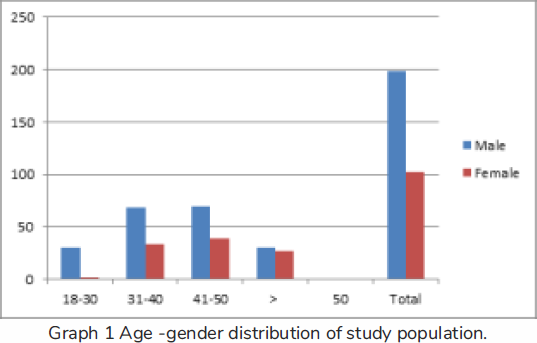
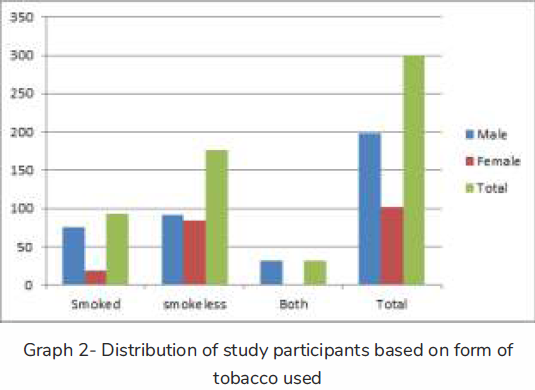
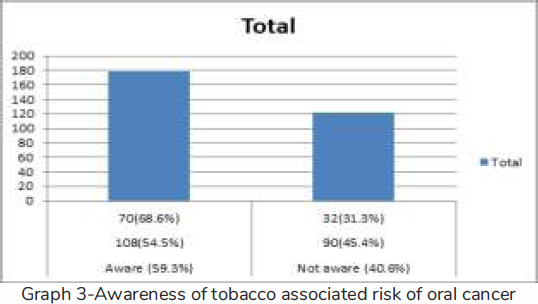
RESULT:
A total 300 questionnaires were analyzed, out of which male was 198 and female was 102 (table.1) among them 93 patients were indulged in the habits of smoking and 7 6 of them were chewing smokeless form of tobacco. (Table 2).
| Age- group | Male | Female |
|---|---|---|
| 18-30 | 30 | 02 |
| 31-40 | 68 | 34 |
| 41-50 | 70 | 39 |
| >=50 | 30 | 27 |
| Total | 198 | 102 |
| Form of Tobacco Used | Male | Female | Total |
|---|---|---|---|
| Smoked | 75 | 18 | 93 |
| smokeless | 92 | 84 | 176 |
| Both | 31 | 0 | 31 |
| Total | 198 | 102 | 300 |
The habit of both smoking and smokeless tobacco was seen in 31 patients (Table 2) When assessed for the prevalence according to the gender males were indulged predominantly in smoking than female. The irony was that in consumption of any form of tobacco males were significantly involved in outrageous members the females.
More than half of the subjects 178 were aware of related risk of development of oral cancer. (Table 3) if compared gender wise male were more aware of harmful effect of oral cancer than females.
| Gender | Aware (59.3%) | Not aware (40.6%) |
|---|---|---|
| Male | 108(54.5%) | 90(45.4%) |
| Female | 70(68.6%) | 32(31.3%) |
| Total | 178 | 122 |
| Questionnaire (Responses in Yes) | Male | Female | TOTAL | |||||
|---|---|---|---|---|---|---|---|---|
| 1. Tobacco smoking is harmful. | 116 | 62 | 178 | |||||
| 2. Want to stop tobacco habit. | 32 | 10 | 42 | |||||
| 3. Tried to stop the habit. | 15 | 8 | 23 | |||||
| 4. Occasional tobacco use is injurious to health | 77 | 23 | 100 | |||||
| 5. Taking chewable tobacco causes oral cancer | 21 | 4 | 25 | |||||
| 6. Oral cancer can cause death. | 0 | 0 | 0 | |||||
| 7. Type of tobacco chewing used | Snuff | gutkha | panmasala | Others | ||||
| M | F | M | F | M | F | M | F | |
| 22 | 14 | 36 | 35 | 32 | 29 | 2 | 6 | |
| 8. At what age tobacco started in any form | M | F | M | F | M | F | M | F |
| 10-20yrs | 21-30yrs | 31-40yrs | Above 40 | |||||
| 50 | 0 | 98 | 10 | 78 | 48 | 10 | 6 | |
| M | F | M | F | M | F | M | F | |
| 9. Type of smoking tobacco used. | Cigarette | beedi | Pipe | Cigar | ||||
| 25 | 0 | 34 | 6 | 6 | 3 | 10 | 9 | |
| 10. Duration of tobacco use | M | F | M | F | M | F | M | F |
| <= 5 yrs | 6-10 yrs | 11-20 yrs | >20 yr | |||||
| 53 | 33 | 70 | 36 | 42 | 18 | 33 | 15 | |
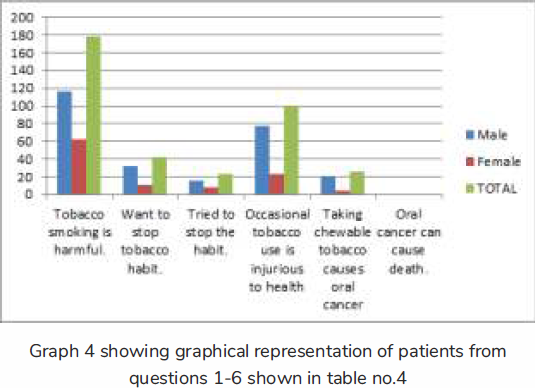
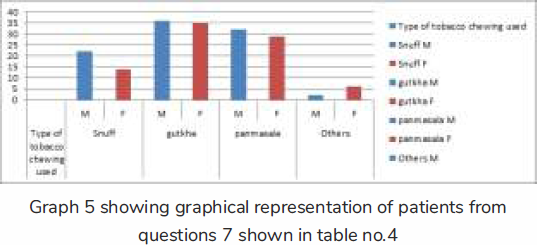
DISCUSSION:
The main cause of oral cancers in India is tobacco and alcohol, which are consumed in various forms. The lack of knowledge among the public has been considered to be a significant barrier in the early detection of oral cancer.
The International Agency for research on cancers is expecting an Epidemic of Oral cancer by 2030. This can be largely attributed to the culturally used risk factors, like pan and tobacco 20 This study was designed to investigate and document the understanding of Oral cancer among the dental patients visiting index institute of dental sciences.
The results of the present study shows that 40.6% of the study participants in this study had never heard of oral cancer and unaware about the signs, symptoms and complications of oral cancer which was in accordance with the study by Park et al.21 and Shah et al.22 and research in Turkey revealed that 60.7% of participants had never heard of oral cancer (Peker and Alkurt23 This study demonstrated general lack of knowledge about (Oral Cancer) among the participants which is not a satisfactory rate compared with oral cancer awareness in most of other studies. In Sri Lanka (Ariyawardana and Vithanaarachchi, 2005),24 South India (Srikanth Reddy., 2012),25 and Gorakhpur city in India (Agrawalet al., 2012)26 95%, 60.2% and 90% of the respondents had heard of oral cancer, respectively.
Questionnaire used in this study
Do you think the tobacco smoking is harmful.?
Do you want to stop tobacco habit.?
-
Type of tobacco chewing used ?
Snuff, gutkha, panmasala others
-
At what age tobacco started ?
10-20y 21-30y 31-40y nd above
-
What is the type of smoking tobacco used. ?
Cigarette, beedi, pipe, cigar
-
Duration of tobacco use?
<= 5 yrs 6-10 yrs 11-20 yrs more than 20 yr
Have you ever tried to stop the habit.?
-
Duration of stopping the habit.?
Not stopped <6 month 6 month to 1 yr > 1 yr
Reason of stopping the habit?
Is tobacco smoking is harmful to you.?
Do you think occasional tobacco use is injurious to health?
Taking chewable tobacco causes oral cancer?
Oral cancer can cause death?
CONCLUSION:
This study concluded that the dental patients still had a lack of awareness regarding the risk of oral cancer, early signs and symptoms and the benefits of detecting this disease at an early stage. Efforts should be made to create awareness about the oral cancer and to control tobacco use in the country by improving the number and quality of services.
REFERENCES:
- A Study on Tobacco Cessation by Clinical Pharmacist. Indian Journal of Pharmacy Practice. 2013;6(1)
- [Google Scholar]
- Implementation and Challenges. Indian J Public Health. 2011;55:220-7. Pharmacy Practice. 2013;6:36-40.
- [CrossRef] [PubMed] [Google Scholar]
- Urban and rural disparity in tobacco use and knowledge about oral cancer among adolescents: an epidemiological survey on 12 and 15-year school going students. Journal of International Society of Preventive & Community Dentistry. 2016;6(Suppl 3):S226.
- [CrossRef] [PubMed] [Google Scholar]
- Tobacco use among school children in Chennai city, India. Indian journal of cancer. 2006;43(3):127.
- [CrossRef] [PubMed] [Google Scholar]
- Awareness of oral cancer and precancer among patients attending a hospital in Sri Lanka. Asian Pac J cancer prev. 2005;6(1):58-61.
- [Google Scholar]
- Oral cancer awareness and knowledge in the city of Valongo, Portugal. International journal of dentistry. 2012;7:2012.
- [CrossRef] [PubMed] [Google Scholar]
- Evaluation of a specially designed tobacco control program to reduce tobacco use among school children in Kerala. Asian Pacific Journal of Cancer Prevention. 2013;14(6):3455-9.
- [CrossRef] [PubMed] [Google Scholar]
- Global epidemiology of oral and oropharyngeal cancer. Oral oncology. 2009;45(45):309-16.
- [CrossRef] [PubMed] [Google Scholar]
- GLOBOCAN 2012 v1.0, Cancer Incidence and Mortality Worldwide: IARC CancerBase No. 11 [Internet] Vol 2013. Lyon, France: International Agency for Research on Cancer; 2013. Available from: http://globocan.iarc.fr, accessed on day/month/year
- [Google Scholar]
- Oral cancer awareness and screening perception among dental patients in Karachi, Pakistan. EC Dental Science. 2019;18:1104-8.
- [Google Scholar]
- Awareness and knowledge of oral cancer and potentially malignant oral disorders among dental patients in far North Queensland, Australia. Asian Pacific Journal of Cancer Prevention. 2015;16(10):4429-34.
- [CrossRef] [PubMed] [Google Scholar]
- Cigarette smoking: an epidemiological overview. British medical bulletin. 1996;52:3-11.
- [CrossRef] [PubMed] [Google Scholar]
- WHO report on the global tobacco epidemic, 2011: warning aboutthe dangers of tobacco. 2011. Geneva: World Health Organization;
- [Google Scholar]
- Mortality in relation to smoking: 50 years' observations on male British doctors. BMJ. 2004;26:1519-33.
- [CrossRef] [PubMed] [Google Scholar]
- Projections of global mortality and burden of disease from 2002 to 2030. PLoS Med. 2006;3(11):e442.
- [CrossRef] [PubMed] [Google Scholar]
- Oral cancer awareness among dental patients in Omdurman, Sudan: A cross-sectional study. BMC Oral Health. 2017;17(1):1-9.
- [CrossRef] [PubMed] [Google Scholar]
- Early detection of oral cancer-dentists' knowledge and practices in the United Arab Emirates. Asian Pacific journal of cancer prevention: APJCP. 2018;19(8):2351.
- [Google Scholar]
- Risk factors of oral cancer in Lahore, Pakistan: A case control design. Proceeding SZPGMI Vol. 2015;29(1):47-54.
- [Google Scholar]
- Knowledge and perceptions regarding oral and pharyngeal carcinoma among adult dental patients. Australian dental journal. 2011;56(3):284-9.
- [CrossRef] [PubMed] [Google Scholar]
- Awareness of oral cancer in rural Bangalore population: A questionnaire based study. International Journal of Scientific Study. 2014;1(6):14-6.
- [Google Scholar]
- Public awareness level of oral cancer in a group of dental patients. J Contemp Dent Pract. 2010;11(2):049-56.
- [CrossRef] [Google Scholar]
- Awareness of oral cancer and precancer among patients attending a hospital in Sri Lanka. Asian Pac J Cancer Prev. 2005;6:58-61.
- [Google Scholar]
- Oral cancer awareness and knowledge among dental patients in South India. Journal of Cranio-Maxillofacial Surgery. 2012;40(6):521-4.
- [CrossRef] [PubMed] [Google Scholar]
- Oral cancer awareness of the general public in Gorakhpur city, India. Asian Pacific Journal of Cancer Prevention. 2012;13(10):5195-9.
- [CrossRef] [PubMed] [Google Scholar]







